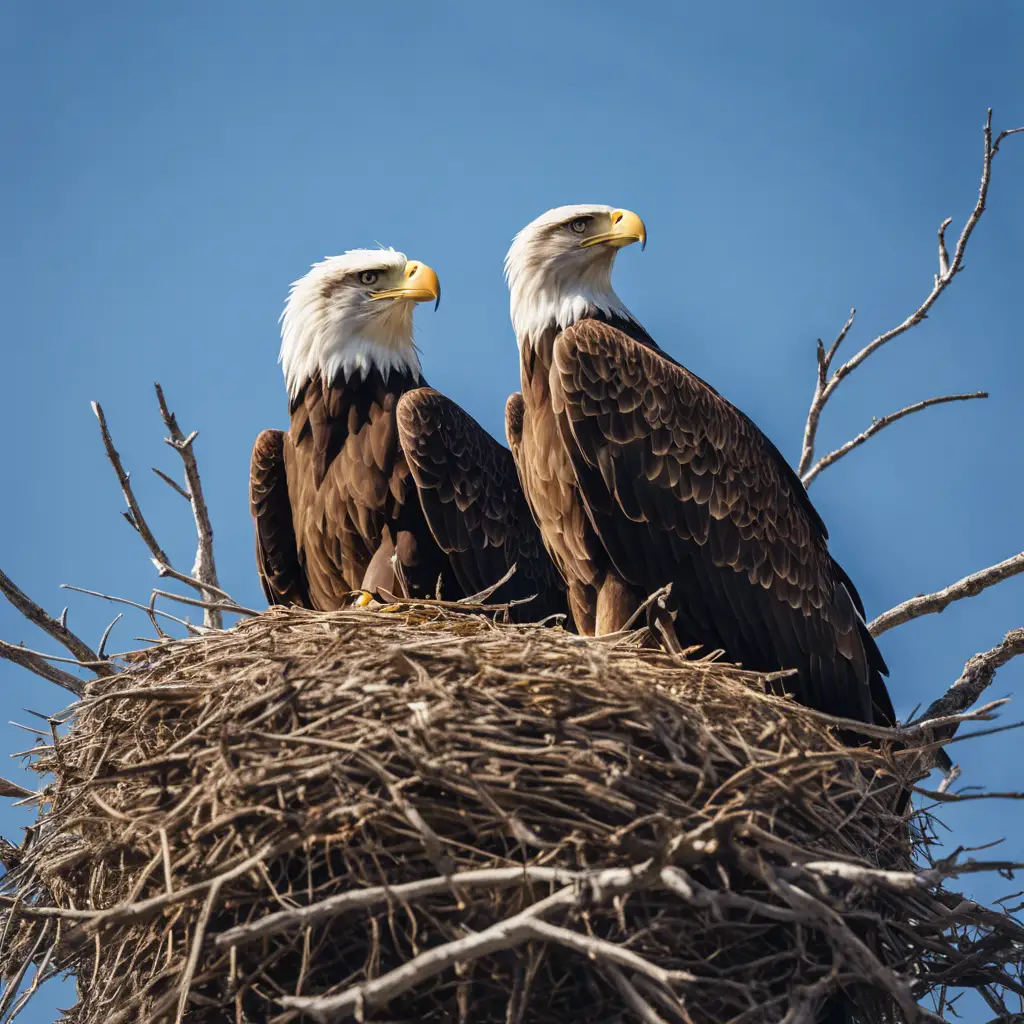As a seasoned ornithologist, my experience observing eaglets has been profoundly impactful. I’ve spent countless hours marveling at their transformative journey.
From the moment they emerge as fluffy down-covered eaglets, my heart swells with anticipation for their future triumphs. I believe there’s a profound connection between their growth and our own human challenges. Watching them develop from dependent chicks into symbols of strength mirrors our own paths to independence.
The dedication of eagle parents reminds me of the nurturing and guidance we all require. Each sighting reinforces my deep admiration for these creatures and the intricate balance of nature they represent.
Key Takeaways
- Baby eagles are called eaglets and they stay in the nest for about three months.
- Eaglets rely on their parents, particularly their mothers, for food and guidance.
- Eagle nests are carefully constructed by female eagles and are perched high above the ground for security.
- Young eagles go through various challenges and learning stages before becoming independent fledglings.
The Eaglet: Eagle Offspring

When observing the early stages of an eagle’s life, it’s fascinating to note that eaglets remain in the nest for about three months, relying on their mothers while mastering the art of flight around the twelve-week mark. Baby eagles, or eaglets as they’re often called, are born in nests constructed meticulously by female eagles. These nests are perched high above the ground and crafted from sticks, dried grass, and feathers, providing a secure haven for the chicks.
Initially, eaglets are tiny and covered in gray feathers, which contrasts sharply with their parents’ imposing brown and white plumage. Over time, these feathers will change as the eaglets mature. With eyes positioned on each side of their heads, these weeks-old birds possess a remarkable 340-degree field of vision, a trait that will become vital for spotting prey from great distances as they grow.
Growth Stages of Eaglets

As eaglets progress through their early life stages, they experience significant physical and behavioral changes, transitioning from helpless chicks to majestic, soaring juveniles. Born with an egg tooth to break free from their shells, eaglets are initially covered in thick fluffy brown down. Parents feed their chicks by regurgitating food until they can tear and eat on their own, usually after three to four weeks.
By six weeks, flight feathers begin to emerge, replacing the down with mottled plumage, a precursor to the adult pattern. Bald Eagles, for instance, don’t reach full adulthood until their distinctive white head and tail feathers develop, a process that may take up to four to eight years.
| Age Stage | Physical Development | Behavioral Milestone |
|---|---|---|
| Hatchling | Thick fluffy down, uses egg tooth | Dependent on parents |
| 6 Weeks | Growth of flight feathers | Practice flapping, pre-flight |
| Juvenile | Mottled plumage | Begins to fly, hunt independently |
Eagle Parenting and Protection

Building on the understanding of eaglet development, it’s crucial to explore the role eagle parents play in nurturing and safeguarding their offspring throughout these formative stages. Baby eagles, called eaglets, stay in the nest under the watchful eyes of mom and dad, who both take part in raising and protecting them.
The male and female parents bring food, and the mother often feeds the chicks, ensuring they receive the nutrition necessary for growth. These parents protect the eagle eggs and the young eagles with their exceptional vision and vigilance.
Eagles eat a variety of prey, and the parents teach their young essential hunting skills. The eaglets learn from their parents until they mature, gradually mastering survival techniques within their carefully constructed, high-altitude nests.
Challenges for Young Eagles

Despite their impressive early development, young eagles face numerous challenges as they grow. This includes the need to quickly master complex hunting techniques and navigate environmental threats. As a baby eagle, known as an ‘eaglet’, you look quite different from adult birds of prey, with your fluffy down and changing colors.
As you transition from an eaglet to a juvenile eagle, you must learn to cope with various hurdles. These include adapting to harsh weather conditions that can affect your survival, perfecting hunting skills to capture prey efficiently, avoiding predators and human-induced hazards, navigating the complex social structure of eagle communities, and learning to live independently after leaving the nest and no longer staying with your parents.
These are critical steps you must take before being called fledglings, ready to conquer the skies.
Frequently Asked Questions
What Is the Name of a Juvenile Eagle?
You’re curious about juvenile eagles? They’re referred to as eaglets, chicks, or fledglings, depending on their age and stage of development before they reach full adulthood at around four years old.
What Are the Offspring of Eagles Called?
You’re inquiring about eagle offspring; they’re known as eaglets. These chicks, with fluffy down and sharp beaks, spend three months in the nest before they’re ready to join a new flock.
What Is a Female Eagle Called?
A female eagle is known as a hen. You’ll find her larger than the male, expertly nurturing her eaglets in the nest, and teaching them essential survival skills after they hatch.
How Many Babies Can an Eagle Have?
An eagle can have 1 to 3 babies, typically called eaglets, per clutch, with 2 being the average. Factors like food and nest quality affect how many they successfully raise.
Conclusion
You’ve learned that baby eagles, known as eaglets, undergo significant changes in their first three months. With thick down and an egg tooth for early feeding, these chicks rapidly grow, thanks to their parents’ diligent care.
Soon, they’ll spread their wings, learning to fly and facing the trials of the wild. As fledglings, they’ll join new flocks, navigating the challenges ahead with the skills instilled by their watchful mothers.
The journey from nestling to soaring eagle is truly remarkable.

An avid ornithologist, zoologist and biologist with an unwavering passion for birds and wild animals.
Dr. Wilson’s journey in ornithology began in childhood and led him to obtain a Ph.D. in Ornithology from the prestigious Avian Research Institute. He has worked closely with renowned experts in the field and conducted extensive research and field studies globally.



